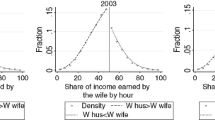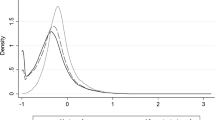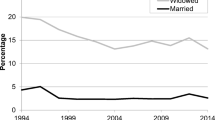Abstract
In what percentage of married couples do wives outearn their husbands, and, moreover, how persistent are these patterns? This study systematically examined variation in point-in-time estimates across alternative measures of earnings, definitions of types of couples, and data sources and gauged the persistence of these patterns for a period of three calendar years using data from the 2000 Current Population Survey and the 1996–2000 Survey of Income and Program Participation. Among the findings are that in 19% to 30% of all married couples, wives have higher earnings than their husbands. In 60% of such couples, this arrangement persists over the three-year period; for the rest, this arrangement is transitory.
Similar content being viewed by others
References
Bittman, M., P. England, N. Folbre, L. Sayer, and G. Matheson. 2003. “When Does Gender Trump Money? Bargaining and Time in Household Work.” American Journal of Sociology 109: 186–214.
Blumberg, R. and M. Tolbert Coleman. 1989. “A Theoretical Look at the Gender Balance of Power in the American Couple.” Journal of Family Issues 10:225–50.
Brennan, R.T., R. Chait Barnett, and K.C. Gareis. 2001. “When She Earns More Than He Does: A Longitudinal Study of Dual-Earner Couples.” Journal of Marriage and the Family 63:168–82.
Brines, J. 1994. “Economic Dependency, Gender, and the Division of Labor at Home.” American Journal of Sociology 100:652–88.
Butrica, B.A., H.M. Iams, and S.H. Sandell. 1999. “Using Data for Couples to Project the Distributional Effects of Changes in Social Security Policy.” Social Security Bulletin 62(3):2–27.
Choi, N.G. 1999. “Racial Differences in the Contribution of Wife’s Earnings to Family Income Distribution.” Journal of Poverty 3(3):33–51.
Freeman, R.B. 2000. “The Feminization of Work in the U.S.: A New Era for (Man)kind?” Pp. 3–22 in Gender and the Labor Market: Econometric Evidence on Obstacles in Achieving Gender Equality, edited by S. Gustafsson and D. Meulders. New York: Macmillan.
Hayghe, H.V. 1993. “Working Wives’ Contributions to Family Incomes.” Monthly Labor Review 116(8):39–43.
Hood, J.C. 1986. “The Provider Role: Its Meaning and Measurement. Journal of Marriage and the Family 48:349–59.
Juhn, C., K.M. Murphy, and R. Topel. 2002. “Current Unemployment, Historically Contemplated.” Prepared for the Brookings Panel on Economic Activity, April 4–5.
Lerman, R.I. 1997. “Is Earnings Inequality Really Increasing?” Policy brief. No. 1 in Series, Economic Restructuring and the Job Market. Washington, DC: Urban Institute.
Lundberg, S.J., R.A. Pollak, and T.J. Wales. 1997. “Do Husbands and Wives Pool Their Resources?” Journal of Human Resources 32:463–80.
Nock, S. 2001. “The Marriages of Equally Dependent Spouses.” Journal of Family Issues 22: 755–75.
Oppenheimer, V. Kincade. 1997. “Women’s Employment and the Gain to Marriage: The Specialization and Trading Model.” Annual Review of Sociology 23:431–53.
Raley, S.B., M.J. Mattingly, and S.M. Bianchi. Forthcoming. “How Dual Are Dual-Income Couples? Documenting Change From 1970 to 2001.” Journal of Marriage and the Family.
Roemer, M.I. 2000. “Assessing the Quality of the March Current Population Survey and the Survey of Income and Program Participation Income Estimates, 1990–1996.” Washington, DC: U.S. Census Bureau.
Sayer, L. and S.M. Bianchi. 2000. “Women’s Economic Independence and the Probability of Divorce.” Journal of Family Issues 21:906–43.
Schultz, T.P. 1997. “Demand for Children in Low Income Countries.” Chap. 6 in Handbook of Population and Family Economics, Volume 1A, edited by M.R. Rosenzweig and O. Stark. Amsterdam: Elsevier.
Sorensen, A. and S. McLanahan. 1987. “Married Women’s Economic Dependency.” American Journal of Sociology 93:659–87.
Stratton, L.S. 2001. “Why Does More Housework Lower Women’s Wages? Testing Hypotheses Involving Job Effort and Hours Flexibility.” Social Science Quarterly 82:67–76.
Weismantle, M. 2001. “Reasons People Do Not Work.” Current Population Reports P70–76. Washington, DC: U.S. Census Bureau.
U.S. Census Bureau. 2004. “Historical Income Tables—Families.” Table F-22. Available on-line at http://hhes/income/histinc/f22.html
Winkler, A.E. 1998. “Earnings of Husbands and Wives in Dual-Earner Families.” Monthly Labor Review (April):42–48.
Winkler, A.E. and D.C. Rose. 2000. “Career Hierarchy in Dual-Earner Families.” Pp. 147–72 in Research in Labor Economics, edited by S. Polachek. Greenwich, CT: JAI Press.
Author information
Authors and Affiliations
Additional information
The authors are grateful for comments from Julie Brines, Marianne Ferber, Howard Iams, Robert Pollak, anonymous referees of this journal, the editors, and participants at the Washington University in St. Louis seminar series on Work, Family, and Public Policy. The authors acknowledge support from the University of Missouri Research Board for this project.
Rights and permissions
About this article
Cite this article
Winkler, A.E., McBride, T.D. & Andrews, C. Wives who outearn their husbands: A transitory or persistent phenomenon for couples?. Demography 42, 523–535 (2005). https://doi.org/10.1353/dem.2005.0028
Issue Date:
DOI: https://doi.org/10.1353/dem.2005.0028




